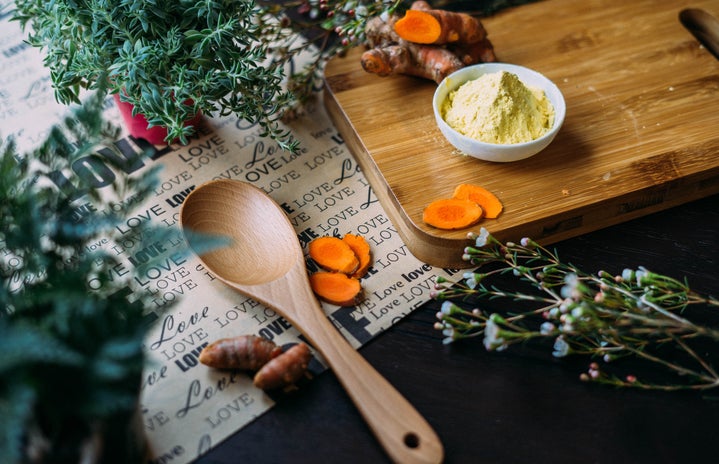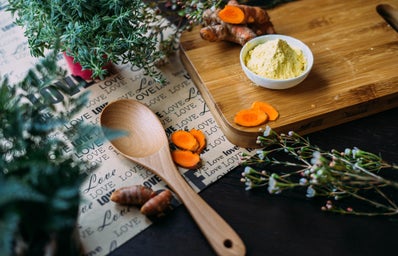Halloween has passed, but that doesn’t mean it’s time to put away the treats. Fall is filled with lots of opportunities for tasty delights — especially ones that come from your oven.
Apples are still in season, and while they’re pretty good on their own, throwing them into a cake form has a magical transformative effect that will leave you wondering why you haven’t gained witch-like powers from Halloween.
This recipe is a simple one to start with. The best part about it — aside from the amazing flavor and wonderful smell that will permeate every part of your apartment — is that you can’t really over bake it. It’s chock-full of apples, so there’s plenty of moistness to go around.
You also don’t need anything fancy to make this cake. You can use a brownie pan instead of a cake pan, and if you don’t have one, just buy a single-use kind from the grocery store.
Caramel Apple Upside-Down Cake
Cake
- 6 large apples
- ½ teaspoon baking soda
- 3 tablespoons butter (plus more for buttering your pan)
- ¼ cup buttermilk
- ¾ cup brown sugar
- 1 tablespoon cinnamon
- 2 eggs
- 1 cup flour
- 1 tablespoon lemon juice
- 1 teaspoon nutmeg
- ½ teaspoon salt
- 1 teaspoon vanilla extract
- ¼ cup white sugar
Caramel
- ½ stick of butter
- 1 cup brown sugar
- ¼ cup half ‘n’ half
Utensils
- Chopping or paring knife
- Whisk (a fork will do, you’ll just be really working that wrist and bicep)
- Cake or brownie pan
- Medium mixing bowl
- Large mixing bowl
- Measuring cups
- Small or medium frying pan
- Rubber spatula or wooden spoon
Crank your oven to 350, and rinse and peel your apples. You can use any combination of apples. Winesap and Fuji apples were used for the test recipe because they were in season at Simmons Farm in McMurray, Pennsylvania.
Completely peel each apple before dicing them.
Cut the cores out of the apples by cutting off each of the four sides of the apples. Cut as close to the core as possible without getting the seeds. Then collect all of the sides of apples and dice apples into half-inch pieces. I recommend slicing the sides in half longways and then cubing the apples from there.
After slicing off each side of the apple, cut the sides in half lengthwise like this.
Then cut the slices in half-inch cubes.
Set aside your apples and prepare yourself for the magic of brown butter. Brown butter is different from melted butter and clarified butter. Ready for a little science?
Take the three tablespoons of butter and melt it in a pan over medium heat. After the butter melts down, your kitchen stove will become the setting for a little lab experiment. The butter will begin to get a little frothy, and from there, the magic starts to happen.
This is what the butter will look like once it’s a perfect golden-brown.
Nice seafood restaurants often serve clarified butter on the side with your dish of crab legs, steamed shrimp, lobster tail or flaky white fish. Brown butter is a step further than the frothy, clarified butter you might’ve had in the past.
From its clarified state, the butter will simmer and begin to separate. The milk particles in the butter will separate and sink to the bottom as the rest begins to turn a golden color. You’ll want to stir occasionally, making sure to scrape the bottom so the milk particles don’t burn. Once it turns a golden-brown color, remove from the heat and put it in a heat-proof bowl. Here’s a video on making brown butter if you want to watch a tutorial.
In the large mixing bowl, whisk together eggs, brown and white sugar and lemon juice until it’s a frothy texture and light yellow color. Then add in the vanilla and buttermilk before tossing in the cooled brown butter. Slowly add the butter so the eggs and buttermilk don’t curdle or cook.
Whisk together the wet ingredients until they’re a frothy, pale yellow mixture.
Add the flour, baking soda, salt, cinnamon and nutmeg into the medium mixing bowl and whisk together with a fork or dry whisk. Then scrape the dry ingredients into the wet bowl, combining with a rubber spatula or spoon. The batter will be similar to that of waffle batter—don’t over mix it.
After combing the dry ingredients, the batter should look similar to a thick waffle batter consistency.
With softened butter, use your hands to rub butter all over the interior of your baking dish. Make sure the whole pan is coated well. You don’t want anything to stick!
Generously rub softened butter all over the pan before filling it to the brim with the cubed apples.
Add all of the cubed apples to the dish. In a nine-inch dish all of the apples will fit in there pretty snugly. Then pour the batter over the top slowly. Let it sink into the cracks. Give the pan a little shake or tap to help it settle, and use a rubber spatula or spoon to make sure the whole top surface is covered with batter.
Pour the batter over the top slowly and let it settle into the crevices. Use a spoon or rubber spatula to smooth out the surface.
Transfer the pan into the middle rack of the oven and bake for 30-45 minutes. You can use a fork or toothpick to test how done the cake is. When you pull out the utensil there shouldn’t be any raw batter, just moist crumbs.
While the cake bakes, melt butter over medium heat, and then slowly add in the half ‘n’ half and sugar. Stir constantly until it melts into a caramel sauce. Set aside until the cake is finished.
Pull out the cake and allow it to cool in the pan for at least 15 minutes. Run a butter knife around the edges of the pan so that the cake isn’t sticking to the sides.
The top of the cake will look a little caramelized when you take it out of the oven. Let it sit for at least 15 minutes before flipping it onto the plate.
Then take a large plate—bigger than the pan so there’s room for the caramel to run over the edges—and place it on the top of the cake, and use oven mitts to grasp the back or the sides of the pan against the plate. Flip both so that the plate is on the bottom and set it on the countertop so that each is in the opposite position as before. Slowly remove the pan.
Take the caramel and pour it evenly over the top of the cake so that it runs all over the surface and down the sides. You can also add walnuts or pecans for a little extra crunch.
Drape the caramel over the top of the cake. You can also add walnuts or pecans to the top before the caramel.
Serve immediately…but not before taking a picture and posting to Instagram. Tag us (@hercampuswvu) so we can see your gorgeous caramel apple upside-down cakes!
This recipe yields about nine generous pieces of cake. Serve warm for dessert—or breakfast if you’re feeling frisky.
This is the perfect cake to bring over for Thanksgiving if you’re looking to make a great first impression. Enjoy!
This recipe was inspired by A.A. Newton’s Mostly Apple Cake recipe in TASTE.
—
Edited by Geena Anderson



